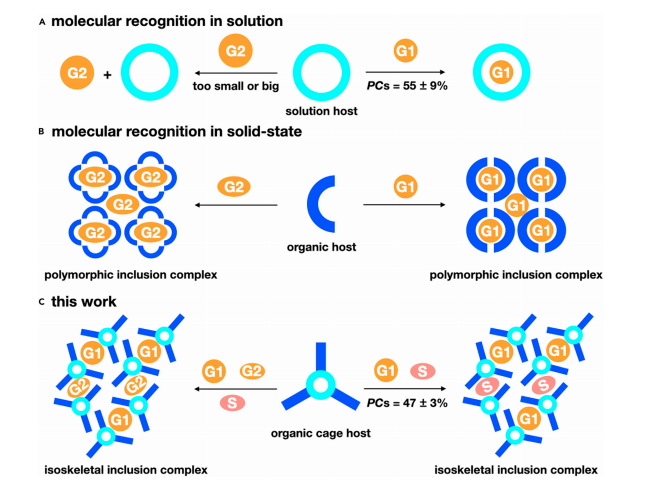
发表论文

Organic cage inclusion crystals exhibiting guest-enhanced multiphoton harvesting

2022-03-28

35
Guo-Hong Ning,* Peng Cui, Igor V. Sazanovich, James T. Pegg, Qiang Zhu, Zhongfu Pang,Rong-Jia Wei, Mike Towrie, Kim E. Jelfs, Marc A. Little,* and And...
查看更多 >
2020-03-30
White Light from Blue Fluorescence and Sensitized Yellow LongAfterglow Phosphorescence of o-Terphenyl in Its π-Acid•••Base Adduct with Ag3Pz3


32次浏览
Abstract:White-light emission with CIE (0.32, 0.34) was realized for an o-terphenyl (oTP) molecule in its Ag3[3,5-(CF3)2Pz]3(Pz = pyrazolate) sandwiching adduct, originating from the hybrid of fluorescence and sensitized long-afterglow phosphorescence of oTP. Density functional theory (DFT) and time-dependent DFT calculations revealed that heavy-atom effects of Ag play acrucial role in sensitization of the triplet of oTP, giving off its ultralong phosphorescence.文章链接:InorgChem201912516.pdf
>
2020-03-30
Assembly of Metal-Organic Frameworks of SiF6 2- in Situ Formed from Borosilicate Glass


34次浏览
Abstract: The SiF62− anions are in situ formed in the reactions of MF2(M = Cu2+, Zn2+, Ni2+, and Co2+) salts and nitrogen-containing ligands in borosilicate glass tubes under solvothermal conditions and then used to further construct a family of metal−organic frameworks (MOFs). This in situ reaction demonstrates a new and facile strategy for the fabrication of MOFs based on SiF62−.文章链接:InorgChem201912501.pdf
>
2020-03-30
Exclusive Recognition of Acetone in a Luminescent BioMOF through Multiple Hydrogen-Bonding Interactions


31次浏览
Astract: An anionic microporous metal-organic framework (1), featuring a combination of mononuclear and tetranuclear zinc clusters and a mix-and-match strategy of two different types of organic ligands, has been successfully constructed via a solvothermal reaction. Its luminescence can be exclusively quenched by acetone. In situ single-crystal X-ray diffraction studies reveal the specific acetone binding sites and the existence of multiple hydrogen bonds between acetone and the framework. Togeth
>
2020-03-30
Tuning the C2/C1 Hydrocarbon Separation Performance in a BioMOF by Surface Functionalization


27次浏览
Abstract:Solvothermal reaction of adenine, 1,3,6,8-tetrakis-(p-benzoic acid)pyrene (H4TBAPy), and Zn(NO3)2 in DMF afforded a three-dimensional anionic bioMOF 1. It features onedimensional tubular channels with exposed Watson–Crick faces and nitrogen-rich purines, which endows 1 with multiple adsorption sites on its polar surface, translating into high selectivity of C2 hydrocarbons over C1. Moreover, an isostructural bioMOF 1-NH2 was synthesized by using 2-aminoadenine in place of adenine, resul
>
2020-03-30
Coordination-driven self-assembly of M10L8 metal-organic bi-capped square antiprisms with adaptable cavities


37次浏览
Astract:A family of polyhedral metal-imidazolate cages based on the flexible bi-imidazole ligand L and Cu2+ ions have been synthesized and characterized, featuring an unusual Cu10L8 bicapped square antiprism structure (or Johnson solids, J17) with an adaptable cavity. These metal–organic cages encapsulate anions, and they will expand or compress after they are filled with different-sized anions.文章链接:DaltonTrans201917713.pdf
>
2020-03-26
Biological metal-organic frameworks: Structures, host-guest chemistry and bio-applications


37次浏览
Hong Cai a, Yong-Liang Huangb, Dan Li b,*ABSTRACT:Biological metal–organic frameworks (BioMOFs) are a new class of crystalline porous materials developed in the last decade that represent a subclass of metal–organic frameworks (MOFs). Biomolecules introduced as components of MOFs confer biological compatibility for this emerging type of material, thus providing new opportunities for applications in biology, medicine, and a variety of other fields. In this review, to focus on host–guest chemistry
>




